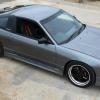Cooling System And Power
Announcements
-
Similar Content
-
Latest Posts
-
By robbo_rb180 · Posted
Best practice for any track day should be Bleed brake fluid, inspect rotors and pads maybe even flip pads if they are prone to tapering. Quality pad (project mu, endless, hawk, winmax, ap), Good high carbon content rotor (dba4000/5000, Ap, projectmu), Quality fluid, Good air supply over the rotor and caliper are all required for best performance at a track day no matter the car. Even the bedding in of the pad and rotor is key to longevity. I've seen so many rotors destroyed on their first track day due to it. -
By Dose Pipe Sutututu · Posted
The hardcore tracks1ut guys I know would flush their brake fluid every 6 to 12 months depending on the amount of track work they did. Unlike most of us SAU guys, probably flush it once a decade 🥲 -
Now that these are NLA, I suspect the answer is going to be to 3D print the plastic bit and glue on some felt or something to replace the brush. I have one or two of them (new) in the shed to go onto the car at some point. I could put some effort into measuring them up and could attempt to draw up the printed part in FreeCAD, if there is interest.
-
By Dose Pipe Sutututu · Posted
Hey team, the R32 ones look different to the R33 and 200SX ones. Also they're sold out on Amayama, looks like some dealer cleaned up the stock. -
By soviet_merlin · Posted
Might have to @Dose Pipe Sutututu him
-







Recommended Posts
Create an account or sign in to comment
You need to be a member in order to leave a comment
Create an account
Sign up for a new account in our community. It's easy!
Register a new accountSign in
Already have an account? Sign in here.
Sign In Now